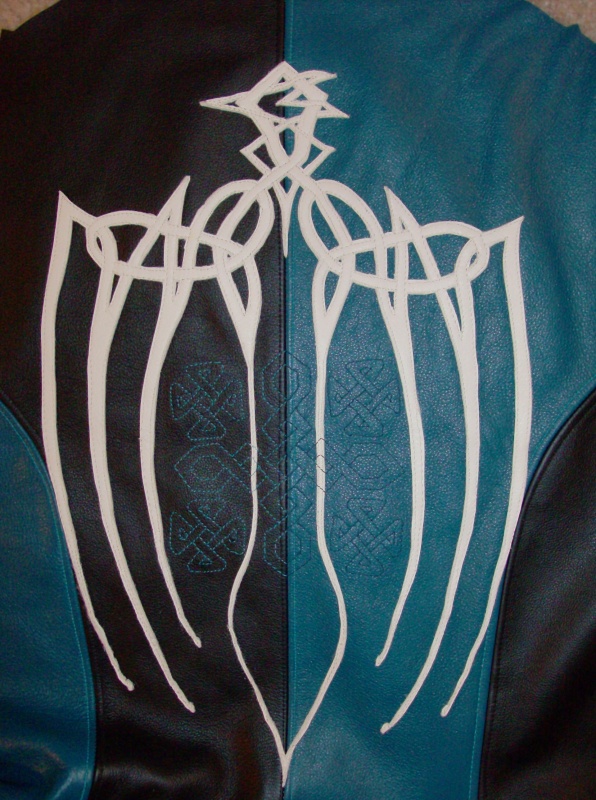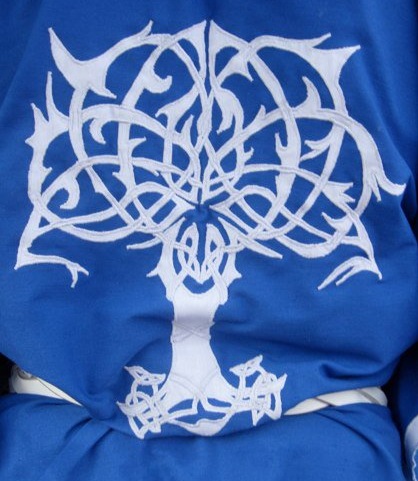Difference between revisions of "Applique"
(→Links) |
m (added category) |
||
| (4 intermediate revisions by one other user not shown) | |||
| Line 2: | Line 2: | ||
In its broadest sense, an applique or appliqué is a smaller ornament or device applied to another surface. In the context of ceramics, for example, an appliqué is a separate piece of clay added to the primary work, generally for the purpose of decoration. | In its broadest sense, an applique or appliqué is a smaller ornament or device applied to another surface. In the context of ceramics, for example, an appliqué is a separate piece of clay added to the primary work, generally for the purpose of decoration. | ||
| − | |||
| − | |||
| − | |||
| + | In the context of sewing, applique refers a needlework technique in which pieces of fabric, embroidery, or other materials are sewn onto another piece of fabric to create designs. It is particularly suitable for work which is to be seen from a distance, such as in banner-making. A famous example of applique is the Hastings Embroidery. | ||
| + | [[File:Leather appique by casca.jpg|thumb|[[Appliqué]] on a [[leather]] coat, owned by [[Kord]] made by [[Casca]] of the [[Iron Mountains]]]] | ||
| + | |||
Applique is used extensively in quilting. "Dresden Plate" and "Sunbonnet Sue" are two examples of traditional American quilt blocks that are constructed with both patchwork and applique. Baltimore album quilts, Broderie perse, Hawaiian quilts, Amish quilts and the ralli quilts of India and Pakistan also use applique. | Applique is used extensively in quilting. "Dresden Plate" and "Sunbonnet Sue" are two examples of traditional American quilt blocks that are constructed with both patchwork and applique. Baltimore album quilts, Broderie perse, Hawaiian quilts, Amish quilts and the ralli quilts of India and Pakistan also use applique. | ||
===Helpful products=== | ===Helpful products=== | ||
Fusible web (sold as Stitch Witchery, Heat N Bond and other trade names) melts to adhere the fabrics together. Fusible web may be available in various weights. Although it may seem like a heavy bond will adhere better, it is not advisable if you will be sewing the edges. Heavy bond will also be stiff after it is melted. Light weight bond is preferable when doing applique. | Fusible web (sold as Stitch Witchery, Heat N Bond and other trade names) melts to adhere the fabrics together. Fusible web may be available in various weights. Although it may seem like a heavy bond will adhere better, it is not advisable if you will be sewing the edges. Heavy bond will also be stiff after it is melted. Light weight bond is preferable when doing applique. | ||
| − | + | [[File:Tunic Applique Shrouding mist.jpg|left|thumb|[[Heraldry]] for the [[chapter]] of [[Shrouding Mist]] Appliquéd on the back of a [[tunic]] ]] | |
===How To=== | ===How To=== | ||
To be sure that the fusible web will adhere to the fabrics, wash the fabric before starting the fusing process. Always read instructions that come with the fusible web. | To be sure that the fusible web will adhere to the fabrics, wash the fabric before starting the fusing process. Always read instructions that come with the fusible web. | ||
| Line 37: | Line 37: | ||
[[Category:How To]] | [[Category:How To]] | ||
| + | [[Category:Unformatted Resources]] | ||
Latest revision as of 03:06, 30 March 2016
Appliques are simple cut outs that are applied to a base fabric.
In its broadest sense, an applique or appliqué is a smaller ornament or device applied to another surface. In the context of ceramics, for example, an appliqué is a separate piece of clay added to the primary work, generally for the purpose of decoration.
In the context of sewing, applique refers a needlework technique in which pieces of fabric, embroidery, or other materials are sewn onto another piece of fabric to create designs. It is particularly suitable for work which is to be seen from a distance, such as in banner-making. A famous example of applique is the Hastings Embroidery.
Applique is used extensively in quilting. "Dresden Plate" and "Sunbonnet Sue" are two examples of traditional American quilt blocks that are constructed with both patchwork and applique. Baltimore album quilts, Broderie perse, Hawaiian quilts, Amish quilts and the ralli quilts of India and Pakistan also use applique.
Helpful products
Fusible web (sold as Stitch Witchery, Heat N Bond and other trade names) melts to adhere the fabrics together. Fusible web may be available in various weights. Although it may seem like a heavy bond will adhere better, it is not advisable if you will be sewing the edges. Heavy bond will also be stiff after it is melted. Light weight bond is preferable when doing applique.
How To
To be sure that the fusible web will adhere to the fabrics, wash the fabric before starting the fusing process. Always read instructions that come with the fusible web.
Once the process to adhere the fabrics is achieved, the raw edges of the applique must be protected or enclosed if the item is going to be laundered. Fabric paint or machine stitching are the most commonly used method to protect the edges of the applique.
For beginner's project simple solids, or Ordinaries, are easiest to start with.
Fuse the melting side of the fusible web to the wrong side of the fabric that you will be appliqueing. Use a scrap of fabric that is larger than the piece of fusible web to eliminate the risk of fusing the web to your ironing surface.
With the fusible web adhered to the fabric, cut along the lines you traced to trim the design. Peel the paper off the fabric.
Lay out the design on the base fabric and press it into place. Turn the fabric over and press from the wrong side.
Transfer any details that are not included in the edge of the design.
Using a satin stitch, enclose the edges of the fabric applique and add the details.

